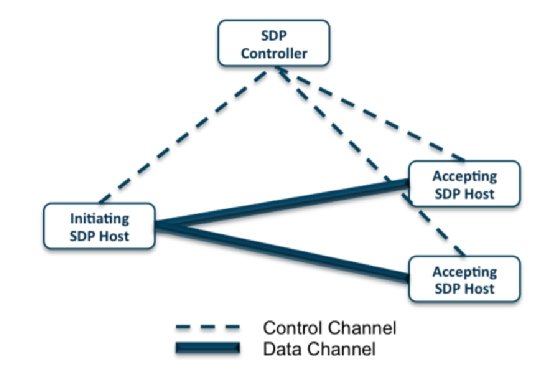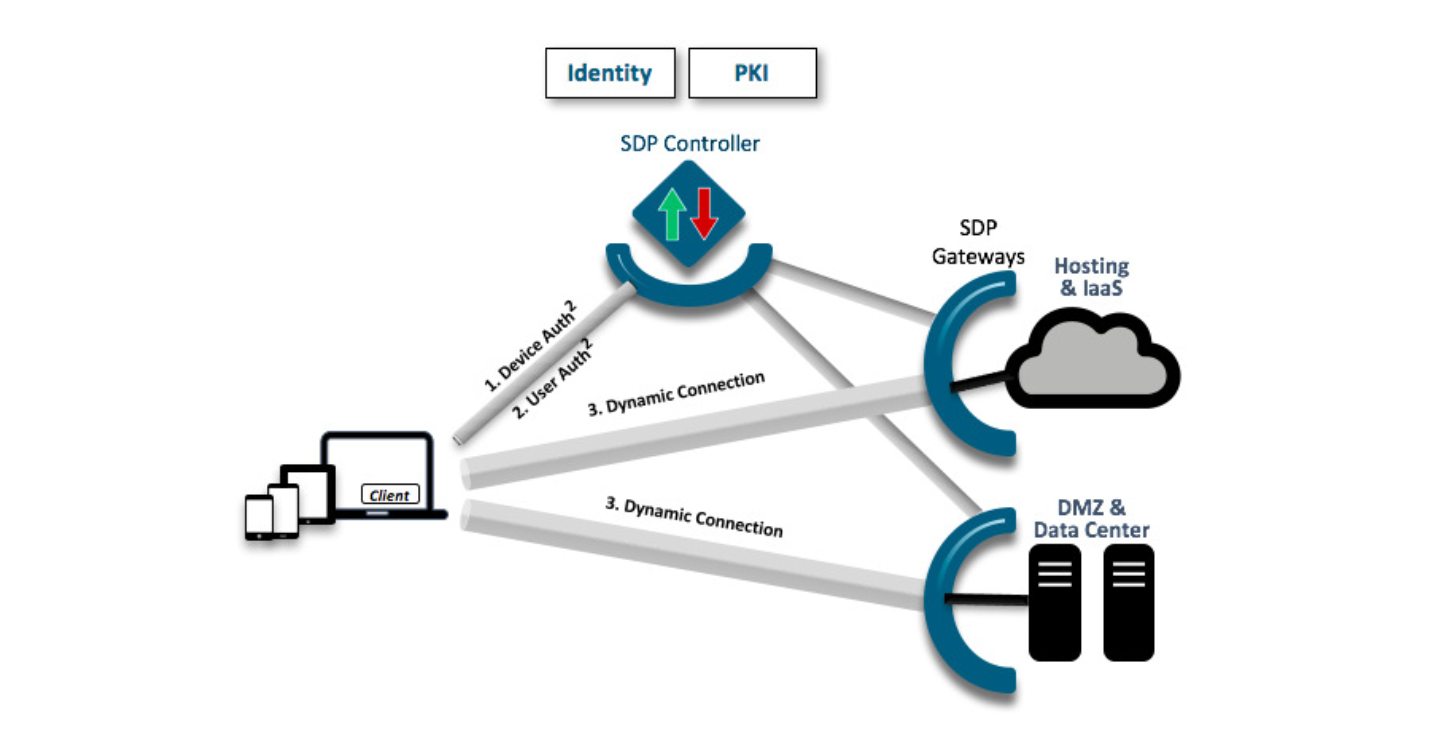Development of a Software Defined Perimeter
Introduction
The Importance of Computer Security
More than ever before, industry and society as a whole are intertwined with computer technology. As a result, computer system failures and security breaches have a significant impact on both. Poor security procedures might end up costing businesses a lot of money. Additionally, they may have a detrimental effect on human activities or even human life. One might look to representative recent occurrences in the realm of computers to better appreciate the growing need for protection against computer threats.
In May 2017, the WannaCry ransomware worm infected over 300,000 computers by taking advantage of a flaw in Microsoft Windows systems. This infection either encrypts the victims’ data or threatens to disclose it unless a ransom is paid. Public services that were employing antiquated software and technology took a severe damage as a result. The main exploits used by this ransomware were EternalBlue and DoublePulsar, which were created by the National Security Agency and became available to the public through the Shadow Brokers group, months before the attack.
Fortunately, Microsoft had released patches to fix them. Even though the WannaCry worm was dealt with, a lot of users can still be victims of the aforementioned tools. Here the key to the exploitation was the outdated software running on the victim’s machines. Since a great number of users depend on obsolete operating systems, such attacks can happen again. However, this attack demonstrates a common pattern among computer threats. When a network of hosts or a host is infected, the damage is inflicted on the machine and not the user’s physical self.
Unfortunately, security issues and hacking apply to many more products that are based on computer technology. Electronic security locks, for example, are widely used by hotels, public services etc. On July 2012, at the Black Hat security conference, [Cody Brocious] (https://www.cbsnews.com/news/ hotel-key-security-flaw-demonstrated-at-black-hat-conference/) presented a mechanism able to crack an electronic keycard system developed by a leading figure in the electronic locks field. What is perhaps more impressive is that the mechanism used a simple Arduino Board. In practice this means that someone with $26 (the price of an Arduino) could gain access to a victim’s physical space. Along the same lines, a handful of vulnerabilities were found on software running on web cameras and baby monitors, allowing hackers to gain control of them. Although only a certain brand was affected by this hack, researchers reported that other brands might have similar vulnerabilities.
Another disturbing incident recently took place at a university: several Internet of Things devices were hacked and used to create a botnet which tried to launch denial-of-host attacks on the university’s network by sending multiple [DNS requests] (http://www.verizonenterprise.com/resources/reports/ rp_data-breach-digest-2017-sneak-peek_xg_en.pdf). Although this attack was not harmful to anything other than the university’s network, the possibility of hackers gaining access to and controlling a whole team of devices can be alarming.
The aforementioned incidents were down to poorly designed and exploitable systems on the hacked products. The first example was a common network attack which aimed to acquire money from its unfortunate victims, and used sophisticated tools in order to gain access to their systems. The other examples, despite being even simpler to perpetrate, managed to get access to devices interconnected with our daily physical activities: web cameras, security locks, university appliances - in other words, Internet of Things (IoT) devices. It is crucial to develop mechanisms that prevent such incidents from happening and provide secure access to services throughout networks.
Building a ‘Dark Cloud’ Using SDP
All of these attacks have something in common, namely the attacker is aware of important information about its targets such as their open ports, message types, applications running. This intelligence can be obtained by the services running on the networked machines. A solution would be for the services to restrict access only to a set of predefined clients. It is obvious, this is a static and highly impractical solution.
However, it is possible that a more viable and efficient solution exists today. In an effort to combat the risk of network attacks, the Defense Information System Agency (DISA) introduced the Software Defined Perimeter (SDP) project.
The project’s aim is to create a so-called Black Cloud: a network that cannot be scanned by any foreign hosts while providing access to services hidden behind the cloud. A basic component of SDP is the Single Packet Authorization (SPA) mechanism, which is used to authorize a client before it can actually connect and access the services of a given host. More concretely, SPA allows clients to transmit authentication information and achieve authentication with another server across closed network ports. Thus, the servers can block access to all of their ports and then allow only authenticated users to connect with them.
The Black Cloud consists of a network of hosts connected together. Every host authenticates itself to the others via the SPA authentication mechanism. Each host is invisible to illegitimate hosts, since it blocks access to all of its ports, therefore the entire Black Cloud structure, since it is composed of such hosts, is theoretically invisible. The SDP provides to its clients the ability to request access to different services from providers across the Black Cloud network. The services are hidden behind the SDP’s complex structure and the clients can not access them directly but through the intermediate nodes of the system which are used as gateways.
The SDP is relatively similar to Network Access Control (NAC), namely it tries to define a set of protocols/solutions in order to securely connect network nodes to each other based on certain policies. However, it can also provide support for network devices, and therefore it can be used as an IoT security mechanism. Another advantage that SDP has over NAC is that SDP can create secure communication tunnels within its structure, between applications (or services) and clients, called Dynamic Tunnel Mode. This is similar to a VPN connection and is used to combat most network attacks.
Singe Packet Authentication (SPA)
Concept
In order to exploit a vulnerability, a hacker has to first discover and scan the target system. Open ports are a good starting point for the perpetrator since they provide a way to discover which services the target machine is providing. One may then check for and exploit corresponding service-specific security issues in a variety of ways, e.g., sniffing and/or altering transmitted data, performing man-in-the-middle attacks, denial-of-service attacks, gaining access or control the target machine via buffer overflows, etc.
The process of scanning is quite easy. The attacker can send packets to target open ports and wait for a response. Based on this response the attacker can gain valuable information about which services run on which ports. For example, nmap [20] is an excellent tool that automates such processes.
A service that regularly deals with client requests could eliminate the threat of scanning by using the firewall to block attackers and allowing firewall access only to legitimate clients. However in this scenario, proper users need to authenticate themselves before establishing a connection. This concept is called “authentication prior to connection”. So far, two implementations exist that try to achieve this: Port-Knocking, and its evolution, Single Packet Authorization (SPA)
Port Knocking
The first approach that was proposed to achieve authentication prior to connection is the so called Port-Knocking Protocol. In order to open a TLS connection with a service running on a server, the client first has to send packets to several different ports belonging to the server according to a predefined sequence: the ports to be addressed and the sequence in which they have to be addressed constitute a secret message/ passphrase.
The server blocks access to all its ports, but monitors the network traffic towards them. When a valid port sequence is identified, the server adds a new firewall rule to allow the sender to communicate with the machine.
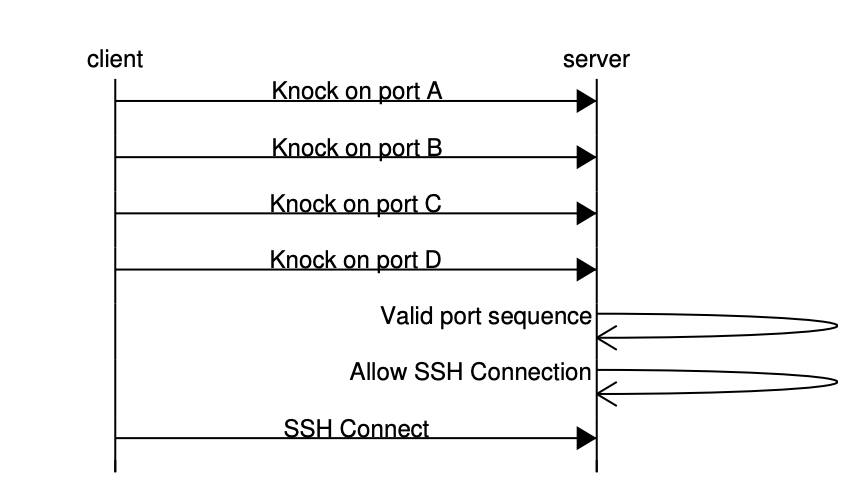
However, the port-knocking sequence can be monitored and replayed by a third party (a replay-attack). Anyone over a local subnet can monitor each of the clients’ transmissions, and then replay the exact same packets to the same ports in order to gain access to the system.
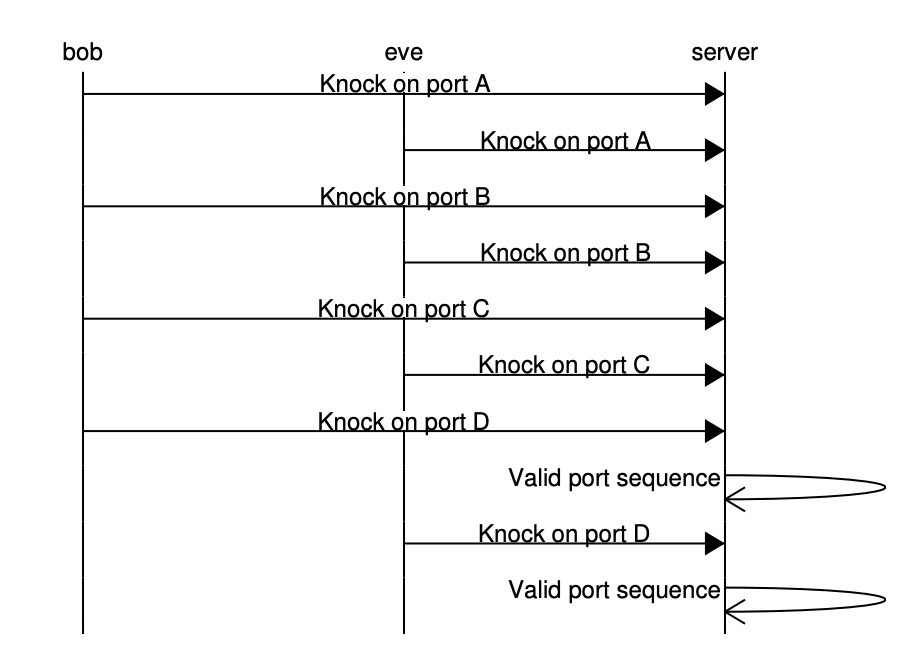
Another problem is that the effective information passed from the client to the server is the port field of the TCP and UDP protocols, which is only 2 bytes long. This means that in order to support a secret message or passphrase of size B one must make B/2 separate packet transmissions. In fact, the process takes even longer as one needs to introduce a time delay between these transmissions, in order to avoid any out-of-order delivery of the sequence packets.
Last but not least, client authorization may fail (the server may consider the client as unauthorized) even if it provides the right sequence of knocks, if a second malicious user spoofs fake port-knock requests at the same time. This attack is not as sophisticated as a replay attack, but can cause trouble with very little effort/ intelligence on the part of the attacker.
SPA
A new mechanism, the so-called Single Packet Authorization (SPA), which has similarities to the port-knocking concept, was presented at the Black Hat conference in 2005 by two research groups (MadHat unspecific and Simple Nomad). In the following years, Michael Rash used the SPA concept to produce his own implementation (open source, available on Github) of the protocol, called fwknop.
Like port-knocking, SPA achieves the authentication of a client to a server. It is assumed that they both own a shared secret seed, which is used for the encryption and decryption of the exchanged messages.
The server behaves in a similar way to port-knocking. It blocks access to all ports, and then passively monitors the network for incoming packets. However, instead of port knocks, the server looks for SPA packets. The server also adds new firewall rules to allow authenticated clients to connect with it.

The client sends an SPA packet when it wants to access a specific port on the server. As in port-knocking, the port to be made eventually accessible to the client, is assumed to be agreed a priori by both the client and the server. More specifically, the SPA packet includes the following information:
- AID : the unique ID of the client that sends this packet
- RANDOM : a random alphanumeric produced by the client before sending the packet
- PASSWORD : the password of the client (also known by the server)
- NEW_SEED : the new value of the shared seed for the next transaction
- MD5_HASH : a hash of the previous values
These values are encrypted using the shared secret seed. The SPA packet consists of the encrypted values along with the AID of the client that is sent in plaintext (used by the server to find the right key for decrypting the packet’s contents).
When a packet with the expected SPA format is received, the server uses the AID value that is enclosed in the packet to determine which client supplied it. The values included in the packet are then decrypted by the server using the shared key connected to the client. If the decryption of the values was succesful, the authentication of the client completes if:
- The PASSWORD in the packet matches the one that is known to server for that client
- The hash of the received values matches the MD5_HASH value received
- The RANDOM value has not been used in a previous SPA packet sent by this client.
Following client authentication, the server authorizes the designated port and changes their shared secret key to the returned NEW_SEED value.
SPA appears to offer security against the majority of computer network assaults, although highly trained hackers can still take advantage of the system. An attacker might keep an eye on the network until a client makes an attempt at SPA authentication, then wait until the client has been authenticated by the server and has been granted access to its firewall before using IP spoofing to hijack the session. If the protected service performs its own authentication check, the issue is then resolved. Instead of attempting to take over the client’s service, the attacker can use IP spoofing to launch a DoS assault on the open port. The SPA is therefore vulnerable to DoS attacks, but only knowledgeable and experienced hackers can carry them out.
During this project I have attempted to create a version of the SPA library (available here) with a few adjustments to the original specification.
Software Defined Perimeter
Concept
The Software Defined Perimeter (SDP), also called Black Cloud, utilizes the SPA protocol in order to provide access to services, by protecting the system from attacks such as server scanning, denial of service, operating system and application vulnerability exploits, and man- in-the-middle attacks (assuming the attacker is not already inside the system).
The Cloud Security Alliance (CSA) has published a software specification document upon which this implementation was based. The CSA’s proposal is similar to a DMZ (demilitarized zone): it isolates one or more services behind a perimeter (the SDP) while clients can access and gain access to services only through the gateways of the SDP.
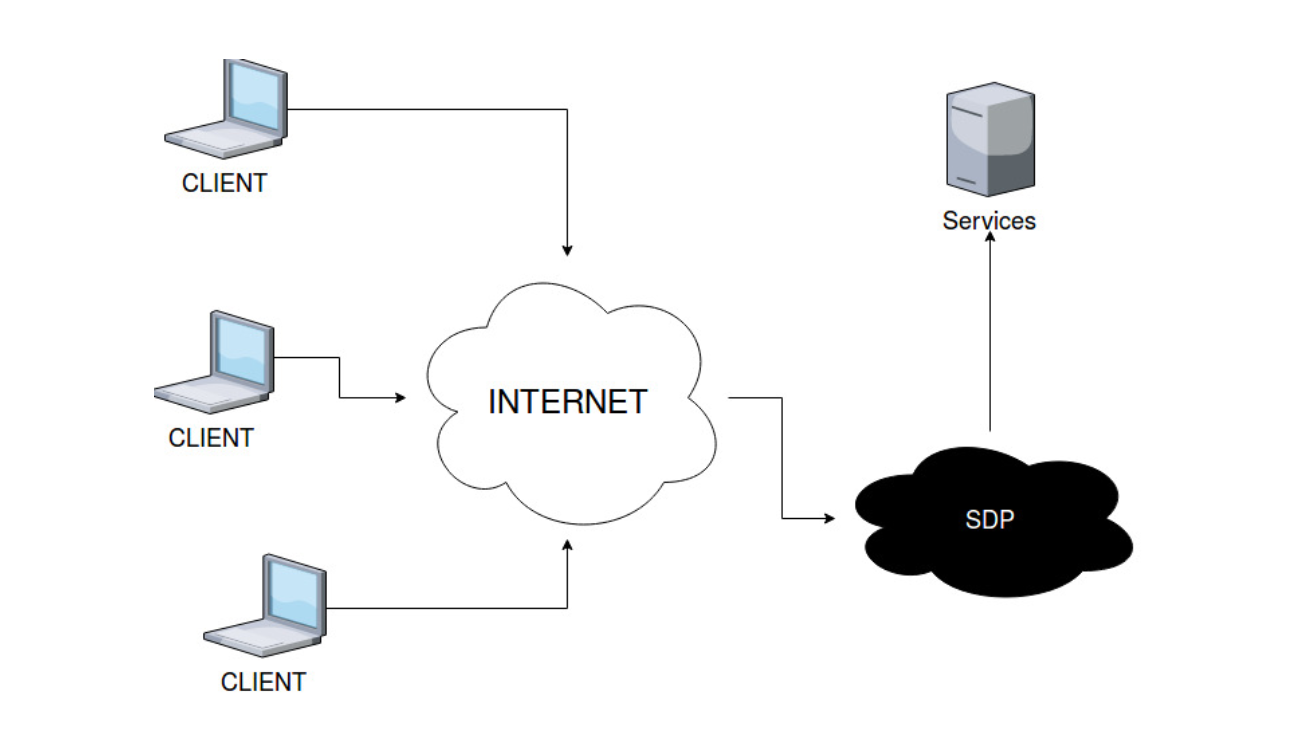
The architecture and functionality of SDP can provide multiple applications such as:
- Enterprise Application Isolation: Highly valuable enterprise applications can be isolated be- hind a Black Cloud while allowing authorized clients to access them.
- Cloud Technology: Multiple clients can be connected through a cloud which uses an SDP to provide various services to each client dynamically.
- Internet of Things: Everyday objects could be connected to an SDP in order to secure data aggregation, component registration and other actions.
Architecture
SDP consists of two components: the SDP Controller (sCTL) and the SDP Hosts. An SDP host can either be an Initiating Host (IH) or an Accepting Host(AH). The SDP Controller (sCTL) manages and authenticates SDP hosts while it also decides which of them communicate with each other.
IH represents the client entity. The IH can request access and communicate with services via the SDP system. The SDP uses AH as gateways to services (thus they are also refered to as SDP Gateways). Their function is similar to a reverse-proxy: they redirect data received from clients to the corresponding services and then forward the services responses back to the clients. The phrase ’AH protects a service’ is used to symbolize that an AH is configured to act as a gateway for a service.
The AH connects and stays connected to an sCTL until its termination. The IH connects to the sCTL in order to search for available services. When the IH selects the service it wants to use, the sCTL instructs it to connect to the corresponding AH which provides these services.
Both AH and sCTL use the SPA in order to authenticate their clients. This means that once started, both hosts will configure their firewall with a strict DROP-all-packets rule. Later on, firewall access will be provided only to authenticated clients.
You can download the SDP thesis and read more about its architecture, my proposed implementation scheme and various edits I made to the original design here.
